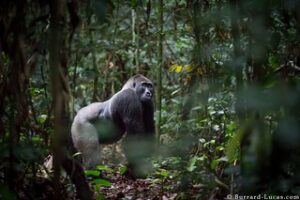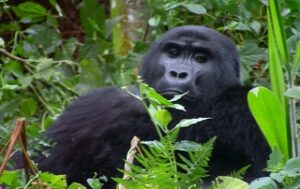Gorillas in Rwanda are the focus of the meticulously planned and strictly monitored experience of getting up close and personal with gorillas. In the Volcanoes National Park, one of the few locations on Earth where these amazing animals can be seen in the wild. Guided excursions are usually used to make this experience possible. The rules in place, the logistics of gorilla trekking, the behavior of the gorillas themselves, and the larger conservation efforts that enable this exceptional interaction are some of the important aspects of the experience that need to be examined to fully comprehend how close one can get to gorillas in Rwanda.
Knowing the Environment of gorillas in Rwanda
A subspecies of the eastern gorilla, mountain gorillas are located in the hilly regions of East Africa, notably the Virunga Mountains, which traverse Rwanda, Uganda, and the Democratic Republic of Congo. There are only about 1000 of these gorillas remaining in the wild owing to habitat destruction, poaching, and conflicts between humans and other species. They are considered highly endangered.
A transboundary region shared by Rwanda, Uganda, and the Democratic Republic of Congo; the Virunga Massif includes the Volcanoes National Park. The park’s steep volcanic slopes and dense bamboo woods are well-known for offering mountain gorillas the perfect place to live. The gorillas’ survival has been greatly aided by the park’s conservation efforts as well as those of nearby nations and international organizations.
Rules and Environmental Initiatives of gorillas in Rwanda
Strict laws have been put in place in Rwanda to save mountain gorillas and promote environmentally friendly travel. These rules include daily caps on the number of tourists allowed in each gorilla group, rules regarding behavior during gorilla trekking, and the use of certified trackers and guides to accompany tourists on treks. The money made by gorilla tourism directly supports local community development and conservation initiatives, encouraging the preservation of gorillas and their natural habitat.
Experience of Trekking gorillas in Rwanda
In Rwanda, gorilla trekking usually begins with an early morning briefing from park rangers. Each small group of visitors is assigned to a particular gorilla family group that has acclimated to human presence. The act of gradually acclimating gorillas to human presence without upsetting them or changing their natural behavior is known as “habituation.”
Depending on where the troop is that day, the gorilla‘ trek through the forest could take anything from thirty minutes to several hours. With its steep hills and thick foliage, the terrain is frequently difficult and calls for a moderate level of physical condition.
Getting to Know the Gorillas in Rwanda
It takes up to an hour to spend time with the gorilla troop after you find them. The behaviour of the gorillas and the rules that park officials and guides provide determine how close you can get to the primates. The objective is to keep a safe distance that minimizes disruption to the gorillas and permits people to have a close-up and unforgettable encounter with nature.
To lessen the chance of disease transmission and to show respect for the gorillas’ space, visitors are urged to maintain a minimum distance of 7 meters (approximately 21 ft) from the animals. Nonetheless, gorillas are known to be inquisitive and may get nearer to people out of curiosity, particularly if they have grown accustomed to seeing people.
Interactions and Behavior of gorillas in Rwanda
Throughout their hour-long visit with the gorillas, guests get to witness a variety of behaviors, such as eating, playing, grooming, and sleeping. Gorillas are gregarious animals that live in family groups headed by a dominant silverback male. The remaining members of the group are females and young gorillas.
Being near gorillas in their natural environment can elicit a variety of feelings, from amazement and exhilaration to a deep sense of bonding with these critically endangered creatures. While taking pictures during the encounter is allowed, flash photography is not allowed to prevent upsetting the gorillas.
Impact of Conservation and Community Participation
In Rwanda, gorilla tourism has greatly benefited local people and conservation efforts. Permit revenue is invested back into park administration, anti-poaching initiatives, community development projects, and education campaigns to increase public knowledge of conservation-related concerns.
The communities that surround the park actively participate in conservation efforts and get jobs as trackers, guides, and lodge employees. Sustainable tourism practices are designed to reduce the impact that tourists have on the environment while offering financial rewards to the locals for preserving the gorillas’ natural habitat.
summary
To sum up, gorilla trekking in Rwanda provides a rare chance to get up close and personal with one of the most iconic and endangered creatures on the planet in their natural environment. Rwanda is a leader in sustainable gorilla tourism, offering incentives for conservation as well as economic gains, thanks to stringent legislation, cautious management, and community involvement.
In addition to providing tourists with an amazing trip, seeing mountain gorillas in the wild is essential to the ongoing efforts to preserve these magnificent animals for future generations. In Rwanda’s Volcanoes National Park, tourists may encounter once-in-a-lifetime wildlife while also helping to conserve mountain gorillas and their habitat by adhering to rules, funding conservation initiatives, and encouraging responsible tourism practices.



